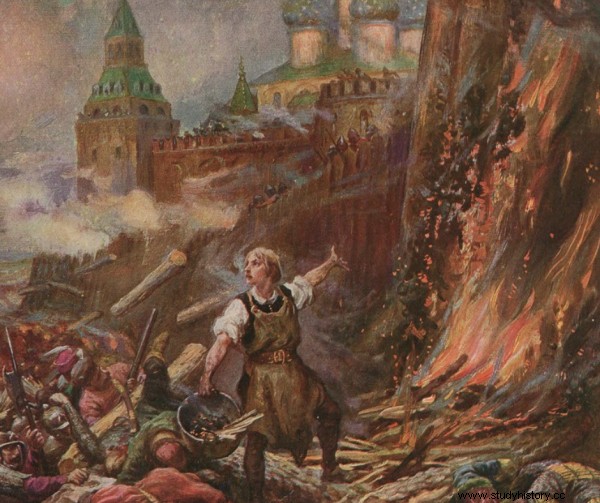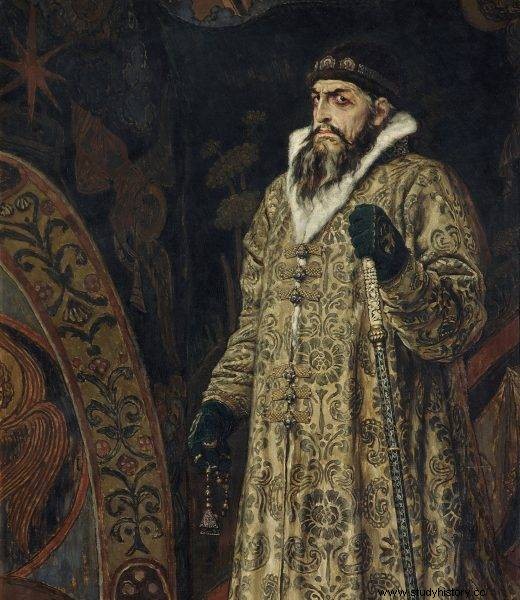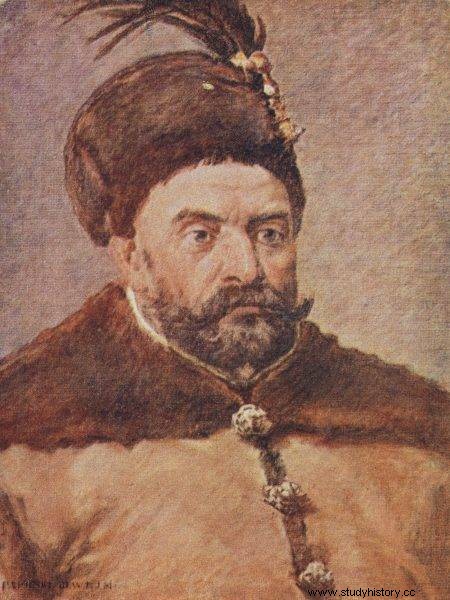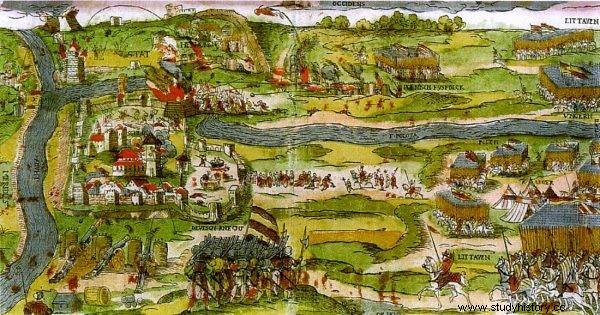The tsar, convinced of the power of his own army, demanded concessions from the Poles, which they could not agree to. The tsar's serious mistake was also to underestimate the new king, who was well versed in warriors. And his soldiers believed that there was an opportunity to acquire inexhaustible treasures.
In 1572, King Zygmunt II August died and the Polish-Lithuanian Commonwealth found itself in a dangerous period of interregnum. It was feared then that Tsar Ivan IV the Terrible would break the truce that had been going on since 1570 in the war for Livonia. However, the latter - deluding hope for the Polish crown or for it to be won by the Habsburgs who maintained good relations with Moscow - kept the treaties concluded.
The tsar's patience ended in 1575. His troops seized the ports of Salis and Pärnu. In January 1577, they appeared in Estonia and attacked Rewel, the last Swedish estate in this area. The siege was unsuccessful and ended in March. At the same time, in the spring, Ivan IV began gathering more troops near Novgorod and Pskov to attack the Polish part of the province.
Dooming confidence
The Moscow army gathered near Pskov had over 30,000 soldiers, so the tsar expected easy success. Moreover, Stefan Batory, already sitting on the Polish throne at that time, was involved from the beginning of 1577 in a conflict with the rebellious Gdańsk after his election. Taking advantage of the situation, in July the main Moscow army led by Ivan IV entered Livonia. By mid-September, these forces had seized 27 castles and strongholds.
Meanwhile, at the end of September 1577, a mass mobilization of Lithuania gathered. Together with a few units of local captaincy, it managed to regain 17 Livonian castles by mid-1578. The counteraction against Moscow troops was successfully paralyzed by the Swedish attack on Narva.

Conquest of Połack according to Konstanty Górski.
As if that were not enough, they, together with the Lithuanian forces, dealt a heavy defeat of the tsarist army at Wenden (Kieś) on October 21, 1578. At the same time, the royal diplomacy managed to win over to the Polish side Prince Magnus Inflancki, who had been supporting Ivan, and eventually fled to Courland. Moreover, apart from the regular Polish and Lithuanian troops, Livonian volunteers joined the fight against the tsar.
Batory, realizing that he was not yet ready for a general hearing with Ivan, pushed MPs to Moscow in January 1578 for negotiations. After obtaining a three-year truce, he began to prepare for war. And already in 1579 he managed to field a fifty-six thousand army with over 90 guns.
Read also: Batory - the worst marriage on the Polish throne?
An army for the age
Meanwhile, Ivan IV disregarded the royal preparations for war . He himself could have an army of 40-48 thousand soldiers in the field supported by various auxiliary units. This could give a total force of about 70,000 armed men. This army, however, was inferior to Batory's forces in terms of armament, organization, discipline and command. The Tsar concentrated his field armies in three groups - at Smolensk, Pskov and Nowogród. The latter broke into Żmudź, but were turned back on the news of Batory's march to Połack.
On June 26, 1579, the king declared war on the tsar and went to Świru near Vilnius, where the concentration of Polish-Lithuanian troops took place. From there, on July 17, the army of almost 42,000 soldiers set out to recapture the land of Połack.

With 30,000 soldiers at his disposal, Ivan the Terrible hoped for an easy victory over the Republic of Poland.
Soon, the light cavalry ledges captured the strongholds of Koziany, Krasne and Sitno. The only threat to the royal army was the heavily manned Falcon. Batory left him behind, not wanting to distract his strength before reaching the main destination of the expedition - Połack.
Siege starts
On August 11, the king stood outside the city. The fortress rebuilt after 1563 consisted of three fortified parts. It was protected from the south by the wide waters of the Daugava River. The so-called High Castle was a key element of the fortifications. It rose on a hill stretching in a bend at the very mouth of the Połota and the Daugava River. Its fortifications and numerous towers were much higher than the remaining city fortifications.
The second most important part of the fortifications was the Strzelecki Castle, defending the eastern border, connected with the High Castle by a wooden and earth embankment. The city proper - Zapołocie - lay to the west of the High Castle. From the south they were flooded by the Daugava River, but the wooden and earth embankments on the north and west sides were protected only by a wide ditch. The fortifications were supported by 8 wooden towers. The town was connected with the High Castle by a wooden bridge across Połota.
The fortifications were wood and earth, additionally covered with clay, which effectively protected the fortifications against setting fire. The Polotsk crew consisted of six thousand soldiers and townspeople with strong artillery including 38 heavy guns and 300 hooklifts.
After the arrival of all troops, a regular siege began. Batory's army surrounded Połack in a huge semicircle, which started on the Daugava River, west of the fortress, and ended also on the river, but east of the fortifications.
As if from the march, Kasper Bekiesz, commanding the Hungarian cavalry, started the bombing of Zapołocie. The shelling turned out to be so effective that the defenders quickly retreated to the castle, setting fire to the buildings and the bridge. Then the Hungarians began to approach the High Castle while digging the aphids. During these works, Bekiesz's guns were constantly firing at the fortifications. Unfortunately, the effects of this bombing turned out to be meager.
Under the Moscow counter-strike that was going on at the same time, Bekesh managed to pull his guns 200–250 meters from the embankments of the High Castle. Soon the Polish battery joined the Hungarian cannonade. Attempts were made to set the fortifications on fire, but to no avail.
From the very beginning, the losses on both sides were high, although for some time it was actually limited to shelling each other with guns. Soon the position of Batory's army became difficult as the Muscovites became active in the rear.
Unrestrained lust for loot
The 5,000-strong army of Boris Shein and Fyodor Sheremetyev was standing near Sokol. In addition, the poorly guarded Krasne Castle fell into the hands of the tsarist troops. Although part of Hetman Krzysztof Radziwiłł's cavalry blocked the castle where the enemy was hiding, Moscow troops tugged Polish and Lithuanian transports with supplies for Batory's army. And with the supplies in the royal camp it was getting worse.
In view of the mounting difficulties, the king called a council of war. Some commanders urged him to storm from all sides. The monarch, however, did not want to risk, believing that in case of failure, it would only be necessary to break the siege.
Ultimately, the assault, which was to be preceded by setting fire to the fortifications of the High Castle, was scheduled for August 29. That day it finally stopped raining and the attackers managed to start a fortification fire . At the sight of the flames, the king led the entire army out of the camp. He placed them with the front in the direction of the Falcon, from which he was afraid of the coming of relief. However, he also wanted to impress the defenders of Polotsk. The fire, the sight of the entire army, and the royal letter calling for surrender and promising grace did their job.

Stefan Batory did not intend to idly watch as Ivan the Terrible expands his influence in the east. Gy only managed to gather a sufficiently large army, he went to war with the tsar.
10 inhabitants of Połoccz jumped from the walls of the fortress with the news that the city wanted to surrender. But Batory's soldiers did not want to surrender. For a long time, rumors circulated among them about the treasures gathered in the fortress. They wanted it, they wanted an attack and loot. So when Bekiesz sent fugitives to the king, the escorting men Hungarian soldiers murdered them on the way . Bekiesz only managed to save one.
As it was already getting dark, the king, not wanting to risk the night battle, postponed the assault until the next day. Meanwhile, the Hungarian detachment rushed without an order to attack. However, he was repulsed, and the defenders chased them. Fortunately, there was a 200-strong Hungarian infantry by the bridge, which stopped the pursuit.
The defenders' counterattack disturbed the Polish commanders. Hetman Mielecki pushed reinforcements into the fight, personally leading the attackers. The king followed his example, but was ultimately prevented from taking such a risky step. However, the attempted night assault was unsuccessful, and this had a terrible effect on the mood of the soldiers.
Meanwhile, the Połocczanie put out the fire and worked throughout the night of August 29-30 on strengthening the embankment, which had already stopped the Hungarians and Poles. Finally, around noon on August 30, the defenders rejected another royal summons to surrender. So Batory immediately ordered to fire the cannons and launch the attack.
Read also:Stefan Batory - the warrior king who reformed the army
Fight or capitulate?
The attack was carried out simultaneously from the north-east, from the north and from the west, from the burnt Zapolocie. Polish and Hungarian infantry, this time supported by volunteers from the cavalry, broke into the High Castle. Taking advantage of the storms' success, the king sent another letter to the Polocchians, summoning them to surrender and offering to treat the defenders graciously.
Then, realizing the location and diminishing chances of surviving the siege, most of the defenders opted for capitulation. Finally, on August 30, the city accepted the royal conditions. They were extremely mild.
The entire crew had the right to return to Moscow. Only the tsarist commanders remained in captivity. All residents could also leave with their movable property. However, weapons and supplies were to go to the royal army. Despite the repressions that threatened to give the city over, almost all inhabitants of the city left it.

16th century depiction of the siege of Połack by Batory's army.
The twenty-day siege of Połack cost the royal army several hundred dead and many more wounded, dead and sick. The losses of the defenders were much greater, although sources exaggeratedly estimate them at several thousand. The winners seized 38 heavy guns, 300 hooklifts, 600 gonets, large supplies of gunpowder and food. The latter made the hungry soldiers the most happy.
After the capture of Polotsk, it was the turn of the smaller castles. Soon, the Falcon, Nieszczedra, Turowla and Drush were captured. The cavalry field of Filon Kmita devastated the Smolensk land, and that of Konstanty Ostrogski - the land of Chernihiv.
At that time, the Moscow field armies behaved passively and did not risk a clash with the forces of the Commonwealth in the open field. In addition, the tsar proposed peace negotiations. However, after the successes of the campaign of 1579, Batory gained self-confidence. In the following years, he managed to persuade the Seym to pay high taxes, which allowed for an effective fight against Moscow.
Finally, in January 1582, a ten-year truce was concluded in Jam Zapolski near Pskov. Under it, the Commonwealth acquired almost all of Livonia, as well as Połock and Wieliż. The pressure of the Moscow state towards the Baltic window on the world was temporarily stopped, but in less than 20 years the Republic of Poland will again fight for Livonia - this time with Sweden
***
You can read about the spectacular victories of our weapon in our latest book "Polish triumphs" . Learn about the clashes that changed the course of history with this richly illustrated publication. From the victorious battles in the times of Bolesław the Brave to the fierce battles of the Second World War.
Find out more:
- Herbst S., Polish military and wars in the period 1576-1648 , [in:] An outline of the history of the Polish military until 1864 , edited by Janusz Sikorski, vol. 1, Publishing House of the Ministry of National Defense, Warsaw 1965.
- You will buy D., Połock 1579 , Bellona, Warsaw 2003.
- Kotarski H., Polish-Lithuanian military of the Batorian era , [in:] History of Polish Military , edited by Witold Biegański et al., Publishing House of the Ministry of National Defense, Warsaw 1972.
- Olejnik K., 1579 Połock , Bellona, Warsaw 2015.
- Olejnik K., Stefan Batory 1533-1586, MON Publishing House, Warsaw 1988.
- Serczyk W.A., Ivan IV the Terrible , Ossolineum, Wrocław 2004.
